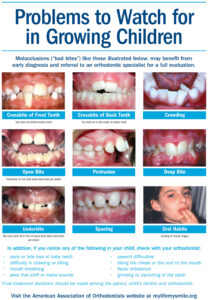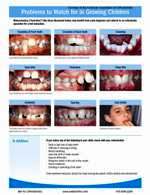 When patients come to our office for their first orthodontic assessment, we’re often asked, “How did my teeth get crooked to begin with?” Teeth erupt crookedly for a number of reasons, ranging from genetics to mouth deformities and serious oral diseases. Here's an overview of the common causes of crooked, twisted or overlapped teeth:
When patients come to our office for their first orthodontic assessment, we’re often asked, “How did my teeth get crooked to begin with?” Teeth erupt crookedly for a number of reasons, ranging from genetics to mouth deformities and serious oral diseases. Here's an overview of the common causes of crooked, twisted or overlapped teeth:
Genetics
The most frequent cause of crooked teeth is genetics. Most of us have about as much control over how our teeth develop as we do over the color of our hair or our eyes! The dental traits that can lead to the crowding of teeth and jaw misalignment are often inherited from our parents.
Crooked teeth are also, in some cases, related to the size of our mouths. If your mouth is too small, there’s a greater chance of crowded teeth that can then cause other teeth to shift from their normal position. Misaligned jaws can also lead to issues like underbites and overbites – abnormal protrusions which result in the upper or lower teeth extending beyond each other.
Bad Habits
Some habits that form during infancy can create a ripple effect that won’t become noticeable until many years later. This can apply to infants that often suck their thumb or fingers for comfort, or use a pacifier for self-soothing, especially if this habit extends well into toddlerhood. Although these behaviors seem harmless (and even helpful to tired parents) they can often lead to the child developing crooked teeth as they grow older.
There are other, mostly unconscious, habits that can contribute to an ongoing misalignment of the jaw and crowding of the teeth, and they include things like breathing through the mouth, tongue thrusting, and reverse swallowing.
Timing
The permanent teeth underneath your baby teeth are directly affected by the health of those baby teeth. If these baby teeth are prematurely lost due to decay, trauma, or other factors, the permanent teeth will shift when they start moving upward. We look at baby teeth like small anchors for permanent teeth that should help to guide them as they erupt through the gums. If those anchors are missing, the permanent teeth may come up in unexpected places.
In addition, taking excellent care of baby teeth is vital to having healthy permanent teeth free of discoloration or decay. Harmful oral bacteria is able to spread into the gums and reach permanent teeth still buried there. Once it attaches to a tooth’s enamel, the bacteria will begin eroding it even before it has a chance to fully erupt.
Illness or injury
Facial trauma, such as a jaw injury or mouth injury, can have the effect of moving teeth out of place. Losing teeth or having your jaw shift due to injury or illness often means that the remaining teeth will slowly shift to make up for that lost space over time. Seeking out orthodontic treatment for these issues is especially important because our bodies compensate for harm much more quickly than the slower changes that happen from genes or bad habits.
Can crooked teeth be prevented?
 Dental abnormalities such as underbites, overbites, and crooked teeth are often inherited traits that can’t be avoided. Orthodontic treatment with braces will be necessary to correct the condition once your child is old enough to wear them. However, certain early childhood behaviors that may also contribute to the development of crooked teeth can be avoided. These include:
Dental abnormalities such as underbites, overbites, and crooked teeth are often inherited traits that can’t be avoided. Orthodontic treatment with braces will be necessary to correct the condition once your child is old enough to wear them. However, certain early childhood behaviors that may also contribute to the development of crooked teeth can be avoided. These include:
- Thumb sucking and tongue thrusting
- Losing baby teeth to decay before permanent teeth have naturally pushed them out of their sockets.
- Allowing pacifier use to continue after front teeth have erupted
When to Start Orthodontic Treatment
Once Dr. Godwin has fully examined your issues, he’ll be able to establish a diagnosis, followed by outlining the best treatment for your teeth or misaligned jaw. Depending on the gravity of the problem, treatment could range from something as simple as a retainer, to something as commonplace as braces, to a more complex option like oral surgery.
While orthodontic treatment can begin at any age, there is definitely a recommended time to begin treatment. Starting at an early age ensures the best possible result, often with the least amount of cost. The American Association of Orthodontists has recommended that children receive their first orthodontic evaluation at the first sign of a problem, usually between ages 7 and 8. Issues like crooked or crowded teeth can benefit greatly from this kind of early intervention and possible treatment. If problems are discovered, it is not unusual to begin orthodontic treatment at that age. In fact, specific conditions such as crossbites and crowding of the teeth are easier to correct at an early age. Early treatment also benefits from the growth process of the jaw which helps move teeth to normal positions.
If you have questions about your child’s teeth, get in touch with Bel Air Orthodontics today to schedule a complimentary initial consultation to find out what we can offer you. We’re here to make sure your child grows up with a beautiful, straight, and most importantly, healthy smile.




 Every October, the American Association of Orthodontists (AAO) takes the spotlight during National Orthodontic Health Month. It’s a time when orthodontists reach out to patients and their community to increase public awareness about the benefits of orthodontic care.
Every October, the American Association of Orthodontists (AAO) takes the spotlight during National Orthodontic Health Month. It’s a time when orthodontists reach out to patients and their community to increase public awareness about the benefits of orthodontic care.








